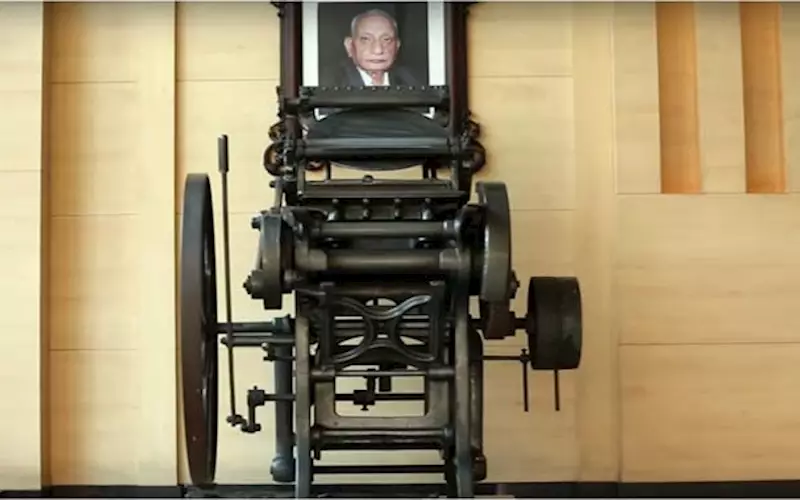Bhuvnesh Seth, managing director at Replika Press, made a presentation about Replika and its place in Indian book printing industry at the Print & Beyond Seminar in Kochi. Edited excerpts
Today, Replika is the synonym of quality. Spread out in an area of 6,46,000 sq/ft in three units located in Export Promotion Industrial Park (EPIP), Kundli, Haryana, the ISO 9001:2015, 14001:2015, FSC, SMETA/PRELIMS BSCI and Sedex-certified company prints and delivers close to 26.5 million books every year.
And, Replika has a host of awards to show for its achievements. It is the winner of PrintWeek India Post-Press Company of the Year five years in a row and was awarded the PrintWeek India Book Printer of the Year (Academic and Trade) in 2017. Other awards include Exporter of the Year from Capexil in 2014 and winner of AIFMP awards like Welbound Best Bound Book, Shri Sudhir Gupta Awards for Best Printing on Indigenous Paper, Fine Art, Books-Soft Bound and Hard Bound in 2015, 2016.
Replika ventured into packaging in 2016-2017 under Replika Packaging and has a capacity to produce 70,000 rigid boxes.
As business grew, two separate entities were created out of the existing printing unit and Replika was born in 1996. It received its first export order from Hodder for 40 titles with split deliveries to UK and India.
From 2003, Replika started attending book fairs. “I met John Strange, group production director, Blackwell Science Oxford, in London Book Fair,” says Bhuvnesh Seth, managing director at Replika Press. “Our real export growth was in 2004-2006. We printed a record 682 titles for Blackwell Science for academic and medical for exports. This translates to three titles a day.”
To add momentum and support to the ongoing success, Seth’s two sons, Sanandan and Vikaran, and his uncle JR Seth joined the business.
In 2007, Blackwell was taken over by Wiley and no order was received in 2007, resulting in 30% loss of export business. In spite of this, the Replika team achieved exports growth by 20%.
Replika’s goodwill into export market resulted in getting good international customers from Australia, Czech Republic, Europe, New Zealand, Russia, UK and US.
In 2008, the company expanded its infrastructure from pre-press to printing and binding with the latest, youngest and best online system of all kinds of binding. It also expanded the working space by investing in land and factory plots next to its existing plant. Total 11 acres of land with covered area of six hundred thousand square feet were added.
Learning from customers
Says Seth: “We have developed long-term business relations for decades with international publishing giants like Penguin Random House, who taught us how to upgrade our printing to international levels.”
Publishing industry at a glance
India is the sixth largest publishing nation in the world. It is around Rs 40,000 crore at present and it is expected to touch Rs 74,000 crore by 2020 at CAGR of 19.3% (The Economic Times, 1 December 2015)
India ranks second among all countries as an English language print book publisher
India has 16,000 publishers that publish books in over 30 languages
Every year, about 77,000 books are published in India, of which 40% are in English
General and literary fiction is the number one genre in the trade books segment while test preparatory books are the most sought-after genre in academic books
The publishing and distribution system is fragmented
Long credit cycles make it difficult to manage cash flows, which increases direct costs
Piracy is widespread
Book printing in India
Seth says India is uniquely positioned to be a back-office support provider for the printing and publishing industry worldwide. “India has availability of low-cost workforce. We also have a large English-speaking population and creative talent. India’s technology and communications costs are falling rapidly, resulting into faster speed delivering quick results,” he argues. Plus, India’s time zone is ideal to serve the East and the West and the country has good connectivity with the entire world.
Challenges
China has been dominating with 80% of the global printing industry because of fast turnaround, pricing, quality, cheap labour and good logistics, says Seth. Also, the government monitors currency fluctuations, protecting risks. Again, the paper is available at competitive prices.
On the other hand, Seth says, in India, shipment can be exported once a week only leading to delay in deliveries. Also, there is a lack in the skilled workforce. “Machines and equipment are IT-friendly, but the persons handling it have little knowledge,” he says, adding, “There is also no liaison between trade and institutes teaching printing. Printing is taught in a traditional way.”
Seth says paper, a major component of book production, constitutes 60% of the total cost. However, paper prices keep fluctuating whereas printers have to enter into minimum two years rate contract with publishers. “Again, specifications of FSC and wood-free paper are expensive. Printers have to absorb such increases as paper mills don’t provide sufficient time to represent.”
To meet the challenge, the printing industry has to find solutions and not fret on declining prices, Seth says, adding, “The inkjet technology is giving us a hard competition in Europe for medical books.”
Seth says printing companies must purchase new equipment and retrain workers to keep up with the technological advancements necessary to meet customer’s expectations.
Another challenge is that the printing industry has been classified under Red Category, meaning, as an industry not favourable to the environment, leading to stiff compliance standards.
Future of book printing
Seth says online sales of books will gain priority due to popularity of eCommerce sites like Amazon and Flipkart, while ebooks, though gaining, should subside in time to come.
“Digital printing will continue to gain importance because of low inventory model and low print runs but will never replace offset printing due to cost, quality and consistency,” says Seth. “Printers are forced to take additional responsibilities of designing, distribution, warehousing and transportation in order to survive tough competition.”
With two government programmes running simultaneously, namely, ‘Sarva Shiksha Abhiyan’ and ‘Beti Padhao Beti Bachao’, there will be more focus and more opportunities for book printing, Seth adds.
Printing industry at a glance
Printing has been growing rapidly over past few years and is expected to touch Rs 4,31,000 crore in 2021 at CAGR of 14% (Statista.com)
Industry has a workforce of two-million
India has 36 printing institutes, some of these are conducting post-graduate education
Printing is largely fragmented as it requires small investment and low entry barriers and due to this, printing industry works on wafer thin margins
The industry has undergone many revolutionary changes in the last 15 years starting with liberalisation of economy in 1990
Information technology is playing a big role in optimising and scaling volumes
Even though we claim printing industry as the third largest industry in the world, it is positioned only in the 26th place in productivity and turnover because of its inherent inefficiencies
















 See All
See All